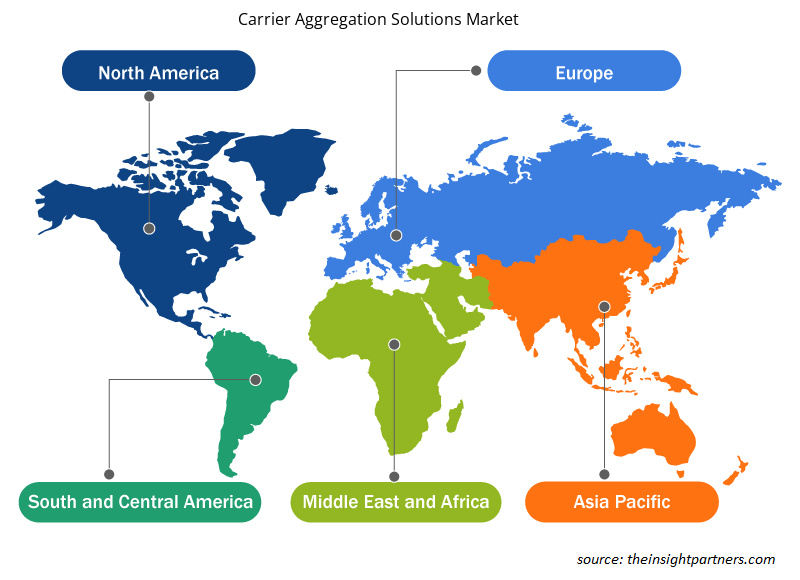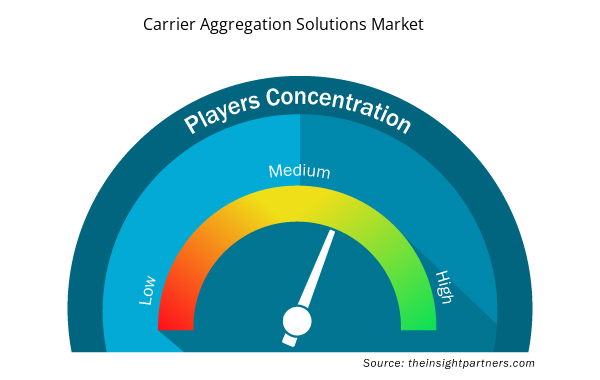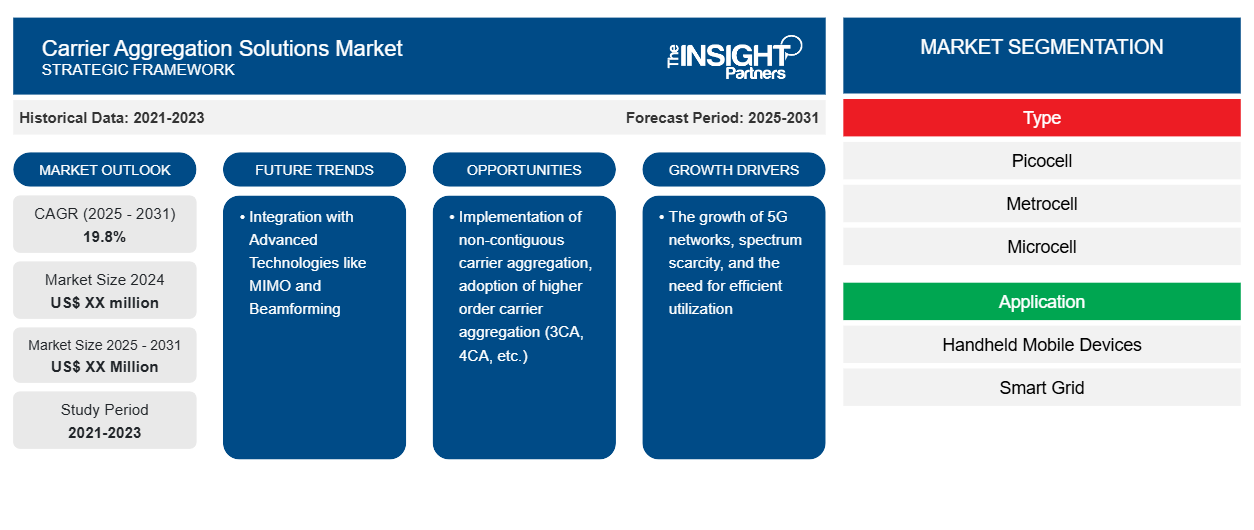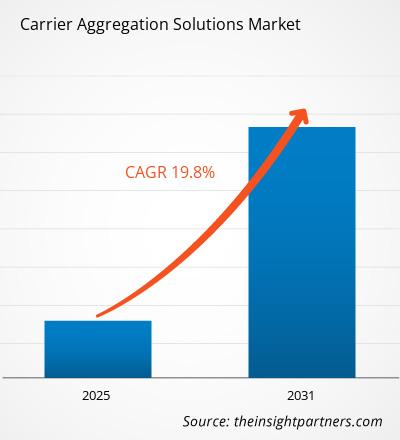预计载波聚合解决方案市场在 2023-2031 年期间的复合年增长率将达到 19.8%。非连续载波聚合的实施和高阶载波聚合(3CA、4CA 等)的采用可能仍是市场的主要趋势。
载波聚合解决方案市场分析
- 在整个预测期内,载波聚合解决方案市场将保持良好的增长前景。移动数据的大幅增加、延迟的降低以及 5G 网络的快速推出正在推动市场增长。
- 各公司正致力于打造高阶载波聚合功能的先进解决方案,以提高网络容量和频谱效率。该技术有望在人口密集地区获得更广泛的应用,以解决城市地区的网络拥堵问题。
- 北美占据市场主导地位,其次是亚太地区。预计欧洲将在未来几年获得显著的市场份额增长。动态频谱共享、训练和 MIMO 的整合是未来市场方向的基本技术支柱。随着 5G 势头强劲并开始在世界各国推广,对复杂载波聚合解决方案的需求预计将大幅增长,为大型供应商和创新型初创公司开辟了绝佳的途径。
载波聚合解决方案市场概览
- 载波聚合解决方案市场受到移动数据流量的复合年增长率、5G 网络的全球部署以及频谱稀缺性的推动。
- 再加上对更先进网络容量和更好用户体验的需求日益增加,运营商不得不部署最新的载波聚合技术。关键机遇包括开发先进的 n64 和 n128 同信道载波聚合解决方案、与网络切片和边缘计算等新兴技术的集成以及扩展频谱规模以涵盖高频段 mmWave 频段。
- 其他机会包括不断发展的物联网生态系统,其中载波聚合可以在复杂的物联网连接要求中发挥作用,以及针对 LTE 和 5G 网络的软件定义网络解决方案,可以增强在各种网络拓扑中部署载波聚合的敏捷性和灵活性。
定制此报告以满足您的需求
您可以免费定制任何报告,包括本报告的部分内容、国家级分析、Excel 数据包,以及为初创企业和大学提供优惠和折扣
- 获取此报告的关键市场趋势。这个免费样品将包括数据分析,从市场趋势到估计和预测。
载波聚合解决方案市场驱动因素和机遇
5G网络增长利好市场
- 智能手机及其不断增长的数据需求正在推动 5G 网络的增长,5G 网络使用载波聚合来增加数据容量和频谱效率,以满足用户的高吞吐量需求。
- 载波聚合将多个频段聚合在一起,增加带宽,并协同使用多个频段,实现更高效的多样化频谱利用。它可提高网络密度,支持运营商的演进和升级,并为 4G 到 5G 的过渡提供更平滑的路线图,充分利用现有频谱并根据需要添加新频段。
- 载波聚合对于改善用户体验至关重要,并且在高级 5G 功能实现(例如超可靠低延迟和网络切片)中发挥着关键作用,因为这些应用对带宽和降低延迟有需求。载波聚合将在 5G 部署过程中发挥关键作用,推动开发新的、更先进的解决方案,以满足下一代网络的复杂需求。
与 MIMO 和波束成形等先进技术的集成
- 与 MIMO(多输入多输出)和波束成形等技术的集成为扩大载波聚合解决方案市场提供了机会,因为协同产品可以为最终用户和网络性能增加价值。MIMO(多输入多输出)和波束成形是分别增强数据吞吐量和频谱效率的无线技术。
- 协同方法与载波聚合配合使用,可形成强大的组合,帮助最大限度地提高网络容量、覆盖范围和最终用户体验。MIMO 系统在接收器和发射器上使用多个天线。通过同时发送多个信号,MIMO 技术可以提高无线下载和上传速度。2013 年,4G 调制解调器也开始实施 MIMO。近年来,真正大规模 MIMO 系统首次进行了实际演示,其阵列由 64 到 128 个天线组成。因此,MIMO 有可能显著提高无线网络中的数据容量。
运营商聚合解决方案市场报告细分分析
有助于得出载波聚合解决方案市场分析的一个关键部分是类型和应用。
- 根据类型,载波聚合解决方案市场分为微蜂窝、城域蜂窝、微蜂窝和微蜂窝。微蜂窝市场在 2023 年占有相当大的份额。
- 根据应用,载波聚合解决方案市场分为手持移动设备、智能电网和其他。
运营商聚合解决方案市场份额分析(按地区)
- 载波聚合解决方案市场报告包括对五个主要地理区域的详细分析,其中包括当前和历史市场规模以及 2021 年至 2031 年的预测,涵盖北美、欧洲、亚太地区 (APAC)、中东和非洲 (MEA) 以及南美洲和中美洲。APAC), Middle East and Africa (MEA), and South & Central America.
- 每个区域进一步细分为各个国家。本报告提供 18 个国家/地区的分析和预测,涵盖运营商聚合解决方案市场动态,例如影响区域市场的驱动因素、趋势和机会。
- 此外,该报告还涵盖 PEST 分析,其中涉及影响这些地区载波聚合解决方案市场的主要因素的研究。
运营商聚合解决方案市场区域洞察
Insight Partners 的分析师已详尽解释了预测期内影响运营商聚合解决方案市场的区域趋势和因素。本节还讨论了北美、欧洲、亚太地区、中东和非洲以及南美和中美洲的运营商聚合解决方案市场细分和地理位置。

- 获取运营商聚合解决方案市场的区域特定数据
运营商聚合解决方案市场报告范围
| 报告属性 | 细节 |
|---|---|
| 2024 年的市场规模 | XX 百万美元 |
| 2031 年市场规模 | XX 百万美元 |
| 全球复合年增长率(2024 - 2031) | 19.8% |
| 史料 | 2021-2023 |
| 预测期 | 2025-2031 |
| 涵盖的领域 | 按类型
|
| 覆盖地区和国家 | 北美
|
| 市场领导者和主要公司简介 |
|
运营商聚合解决方案市场参与者密度:了解其对业务动态的影响
运营商聚合解决方案市场正在快速增长,这得益于终端用户需求的不断增长,而这些需求又源于消费者偏好的不断变化、技术进步以及对产品优势的认识不断提高等因素。随着需求的增加,企业正在扩大其产品范围,进行创新以满足消费者的需求,并利用新兴趋势,从而进一步推动市场增长。
市场参与者密度是指在特定市场或行业内运营的企业或公司的分布情况。它表明在给定市场空间中,相对于其规模或总市场价值,有多少竞争对手(市场参与者)存在。
在运营商聚合解决方案市场运营的主要公司有:
- 安立公司
- Artiza Networks, Inc.
- 思科系统
- 华为技术有限公司
- 诺基亚
- 高通技术公司
免责声明:上面列出的公司没有按照任何特定顺序排列。

- 获取运营商聚合解决方案市场顶级关键参与者概览
载波聚合解决方案市场新闻和最新发展
载波聚合解决方案市场通过收集一手和二手研究后的定性和定量数据进行评估,其中包括重要的公司出版物、协会数据和数据库。载波聚合解决方案市场的一些发展如下所列:
- 安立公司推出其新开发的 Butler Matrix 8x8(0.6 GHz 至 7.125 GHz)MA8118A 模块,可模拟 8x8 MIMO 连接。MA8118A 是一个 Butler Matrix*1 传输路径,具有 8 个输入和 8 个输出端口,并支持上一个模块 Azimuth STACSIM-8x8(静态通道模拟器)(ACC-380)不支持的所有 5G FR1*2 频段(3GPP 2023 年 9 月版)。(来源:安立公司,新闻稿,2023 年 11 月)
- 四川移动联合华为在成都进行了TDD+FDD、TDD+TDD 5G SA 3CC CA现网验证。测试结果表明,华为5G 3CC CA解决方案在复杂空口条件下,将物理层单用户峰值速率提升至4.52Gbps,为6GHz以下频段同类最高。随着5G网络规模部署,高清视频成为主流网络应用,AR业务的快速兴起也对用户体验提出了更高的要求。载波聚合技术通过将多个小载波拼凑在一起,可以增加带宽,从而最大化5G用户感知速率。(来源:华为,新闻稿,2022年4月)
运营商聚合解决方案市场报告覆盖范围和交付成果
“运营商聚合解决方案市场规模和预测(2021-2031)”报告对市场进行了详细分析,涵盖以下领域:
- 范围涵盖的所有关键细分市场的全球、区域和国家/地区运营商聚合解决方案市场规模和预测
- 载波聚合解决方案市场趋势,以及驱动因素、限制因素和关键机遇等市场动态
- 详细的 PEST/波特五力分析和 SWOT 分析
- 载波聚合解决方案市场分析涵盖主要市场趋势、全球和、主要参与者、法规和最新市场发展
- 行业格局和竞争分析,涵盖市场集中度、热图分析、知名参与者以及运营商聚合解决方案市场的最新发展
- 详细的公司简介
- 历史分析(2 年)、基准年、预测(7 年)及复合年增长率
- PEST 和 SWOT 分析
- 市场规模价值/数量 - 全球、区域、国家
- 行业和竞争格局
- Excel 数据集



Report Coverage
Revenue forecast, Company Analysis, Industry landscape, Growth factors, and Trends

Segment Covered
This text is related
to segments covered.

Regional Scope
North America, Europe, Asia Pacific, Middle East & Africa, South & Central America

Country Scope
This text is related
to country scope.
常见问题
The carrier aggregation solutions market is expected to register a CAGR of 19.8% during 2023–2031.
Implementation of non-contiguous carrier aggregation and adoption of higher order carrier aggregation (3CA, 4CA, etc.) are likely to remain key trends in the market.
Anritsu, Artiza Networks, Inc., Cisco Systems, Huawei Technologies, Nokia, Qualcomm Technologies, Inc., Rohde and Schwarz, Sprint.com, and Telefonaktiebolaget LM Ericsson are among the leading payers operating in the carrier aggregation solutions market.
Some of the customization options available based on the request are additional 3–5 company profiles and country-specific analysis of 3–5 countries of your choice. Customizations are to be requested/discussed before making final order confirmation, as our team would review the same and check the feasibility.
The report can be delivered in PDF/PPT format; we can also share an excel dataset based on the request.
The growth of 5G networks, spectrum scarcity, and the need for efficient utilization are expected to drive the carrier aggregation solutions market.
Trends and growth analysis reports related to Technology, Media and Telecommunications : READ MORE..
The List of Companies
1. Anritsu
2. Artiza Networks, Inc.
3. Cisco Systems
4. Huawei Technologies
5. Nokia
6. Qualcomm Technologies, Inc.
7. Rohde and Schwarz
8. Sprint.com
9. Telefonaktiebolaget LM Ericsson
10. ZTE Corporation
The Insight Partners performs research in 4 major stages: Data Collection & Secondary Research, Primary Research, Data Analysis and Data Triangulation & Final Review.
- Data Collection and Secondary Research:
As a market research and consulting firm operating from a decade, we have published and advised several client across the globe. First step for any study will start with an assessment of currently available data and insights from existing reports. Further, historical and current market information is collected from Investor Presentations, Annual Reports, SEC Filings, etc., and other information related to company’s performance and market positioning are gathered from Paid Databases (Factiva, Hoovers, and Reuters) and various other publications available in public domain.
Several associations trade associates, technical forums, institutes, societies and organization are accessed to gain technical as well as market related insights through their publications such as research papers, blogs and press releases related to the studies are referred to get cues about the market. Further, white papers, journals, magazines, and other news articles published in last 3 years are scrutinized and analyzed to understand the current market trends.
- Primary Research:
The primarily interview analysis comprise of data obtained from industry participants interview and answers to survey questions gathered by in-house primary team.
For primary research, interviews are conducted with industry experts/CEOs/Marketing Managers/VPs/Subject Matter Experts from both demand and supply side to get a 360-degree view of the market. The primary team conducts several interviews based on the complexity of the markets to understand the various market trends and dynamics which makes research more credible and precise.
A typical research interview fulfils the following functions:
- Provides first-hand information on the market size, market trends, growth trends, competitive landscape, and outlook
- Validates and strengthens in-house secondary research findings
- Develops the analysis team’s expertise and market understanding
Primary research involves email interactions and telephone interviews for each market, category, segment, and sub-segment across geographies. The participants who typically take part in such a process include, but are not limited to:
- Industry participants: VPs, business development managers, market intelligence managers and national sales managers
- Outside experts: Valuation experts, research analysts and key opinion leaders specializing in the electronics and semiconductor industry.
Below is the breakup of our primary respondents by company, designation, and region:

Once we receive the confirmation from primary research sources or primary respondents, we finalize the base year market estimation and forecast the data as per the macroeconomic and microeconomic factors assessed during data collection.
- Data Analysis:
Once data is validated through both secondary as well as primary respondents, we finalize the market estimations by hypothesis formulation and factor analysis at regional and country level.
- Macro-Economic Factor Analysis:
We analyse macroeconomic indicators such the gross domestic product (GDP), increase in the demand for goods and services across industries, technological advancement, regional economic growth, governmental policies, the influence of COVID-19, PEST analysis, and other aspects. This analysis aids in setting benchmarks for various nations/regions and approximating market splits. Additionally, the general trend of the aforementioned components aid in determining the market's development possibilities.
- Country Level Data:
Various factors that are especially aligned to the country are taken into account to determine the market size for a certain area and country, including the presence of vendors, such as headquarters and offices, the country's GDP, demand patterns, and industry growth. To comprehend the market dynamics for the nation, a number of growth variables, inhibitors, application areas, and current market trends are researched. The aforementioned elements aid in determining the country's overall market's growth potential.
- Company Profile:
The “Table of Contents” is formulated by listing and analyzing more than 25 - 30 companies operating in the market ecosystem across geographies. However, we profile only 10 companies as a standard practice in our syndicate reports. These 10 companies comprise leading, emerging, and regional players. Nonetheless, our analysis is not restricted to the 10 listed companies, we also analyze other companies present in the market to develop a holistic view and understand the prevailing trends. The “Company Profiles” section in the report covers key facts, business description, products & services, financial information, SWOT analysis, and key developments. The financial information presented is extracted from the annual reports and official documents of the publicly listed companies. Upon collecting the information for the sections of respective companies, we verify them via various primary sources and then compile the data in respective company profiles. The company level information helps us in deriving the base number as well as in forecasting the market size.
- Developing Base Number:
Aggregation of sales statistics (2020-2022) and macro-economic factor, and other secondary and primary research insights are utilized to arrive at base number and related market shares for 2022. The data gaps are identified in this step and relevant market data is analyzed, collected from paid primary interviews or databases. On finalizing the base year market size, forecasts are developed on the basis of macro-economic, industry and market growth factors and company level analysis.
- Data Triangulation and Final Review:
The market findings and base year market size calculations are validated from supply as well as demand side. Demand side validations are based on macro-economic factor analysis and benchmarks for respective regions and countries. In case of supply side validations, revenues of major companies are estimated (in case not available) based on industry benchmark, approximate number of employees, product portfolio, and primary interviews revenues are gathered. Further revenue from target product/service segment is assessed to avoid overshooting of market statistics. In case of heavy deviations between supply and demand side values, all thes steps are repeated to achieve synchronization.
We follow an iterative model, wherein we share our research findings with Subject Matter Experts (SME’s) and Key Opinion Leaders (KOLs) until consensus view of the market is not formulated – this model negates any drastic deviation in the opinions of experts. Only validated and universally acceptable research findings are quoted in our reports.
We have important check points that we use to validate our research findings – which we call – data triangulation, where we validate the information, we generate from secondary sources with primary interviews and then we re-validate with our internal data bases and Subject matter experts. This comprehensive model enables us to deliver high quality, reliable data in shortest possible time.


 获取此报告的免费样本
获取此报告的免费样本